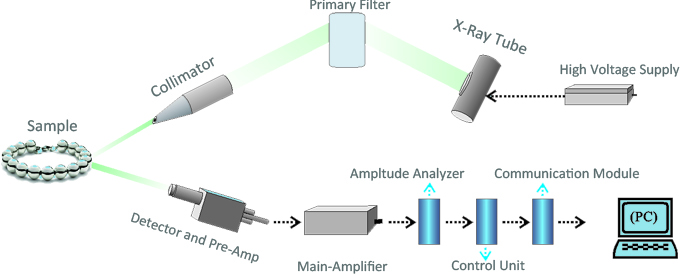X-ray Fluorescence Spectroscopy

X-ray Fluorescence Introduction
X-ray fluorescence spectroscopy was first introduced in 1960s and first commercial XRF instrument was developed in the 1970s since that time XRF Spectrometry became accepted worldwide as the best method for elemental analysis. Over the years XRF became more available to the public and the instruments became more advanced, user friendly, smaller and more cost effective. Today X-ray fluorescence spectroscopy has become an important tool in elemental analysis and companies worldwide are using reliable Skyray XRF Spectrometers for their analysis needs. Skyray instruments offers high performance XRF Instruments and more economical XRF Analyzers to meet every clients application.
X-Ray Fluorescence Theory
An electron can be ejected from its atomic orbital by the absorption of a light wave (photon) of sufficient energy. The energy of the photon must be greater than the energy with which the electron is bound to the nucleus of the atom. When an inner orbital electron is ejected from an atom, an electron from a higher energy level orbital will be transferred to the lower energy level orbital. During this transition a photon maybe emitted from the atom. This is called the X-ray characteristic of the element.
 The energy of the emitted photon will be equal to the difference in energies between the two orbitals occupied by the electron making the transition. Because the energy difference between two specific orbital shells, in a given element, is always the same (i.e. characteristic of a particular element), the photon emitted when an electron moves between these two levels, will always have the same energy. Therefore, by determining the energy (wavelength) of the X-ray
light (photon) emitted by a particular element, it is possible to determine the identity of that element.
The energy of the emitted photon will be equal to the difference in energies between the two orbitals occupied by the electron making the transition. Because the energy difference between two specific orbital shells, in a given element, is always the same (i.e. characteristic of a particular element), the photon emitted when an electron moves between these two levels, will always have the same energy. Therefore, by determining the energy (wavelength) of the X-ray
light (photon) emitted by a particular element, it is possible to determine the identity of that element.
For a particular energy (wavelength) of fluorescent light emitted by an element, the number of photons per unit time (generally referred to as peak intensity or count rate) is related to the amount of that analyte in the sample. The counting rates for all detectable elements within a sample are usually calculated by counting, for a set amount of time, the number of photons that are detected for the various analytes characteristic X-ray energy lines. It is important to note that these fluorescent lines are actually observed as peaks with a semi-Gaussian distribution because of the imperfect resolution of modern detector technology. Therefore, by determining the energy of the X-ray peaks in a sample's spectrum, and by calculating the count rate of the various elemental peaks, it is possible to qualitatively establish the elemental composition of the samples and to quantitatively measure the concentration of these elements.
XRF is generally split in two categories:
EDXRF- Energy Dispersive X-ray Fluorescence relies on XRF detector, which determines the energy of photon when the photon is emitted.
WDXRF-Wavelength Dispersive X-ray Fluorescence which relies on separation of photons by diffraction on a crystal.
Energy Dispersive X-ray Fluorescence EDXRF
Energy Dispersive X-ray Fluorescence (EDXRF) relies on the XRF detector and detector electronics to find spectral peaks due to different energy x-rays. Not until the 1960 and early 1970 that electronics had developed to the point that high-resolution detectors, like lithium drifted silicon, Si(Li),could be made and installed in commercial devices. Computers were also a necessity for the success of EDXRF even if they where often as large as the instrument itself.
Energy Dispersive X-ray Fluorescence (EDXRF) is relatively simple and inexpensive compared to other techniques. It requires and X-ray source, which in most laboratory instruments is a 50 to 60 kV 50-300 W x-ray tube. The second major component is the XRF detector, which must be designed to produce electrical pulses that vary with the energy of the incident x-rays. Most laboratory Energy dispersive x-ray fluorescence instruments still use liquid nitrogen or Peltier cooled Si(Li) detectors, while benchtop instruments usually have proportional counters, or newer Peltier cooled PIN diode detectors, but historically sodium iodide (NaI) detectors were common. Some handheld device use other detectors such as mercuric Iodide, CdTe, and CdZnTe in addition to PIN diode devices depending largely on the x-ray energy of the elements of interest. The most recent and fastest growing detector technology is the Peltier cooled silicon drift detector (SDD), which are available in majority of Skyray XRF Spectrometers.
After the source and detector the next critical component are the x-ray tube filters, which are available in most Energy Dispersive X-ray Fluorescence (EDXRF) instrument. There function is to transmit particular energies of source x-rays more than other in order to reduce the counts in the region of interest while producing a peak that is well suited to exciting the elements of interest. Secondary targets are an alternative to filters. A secondary target material is excited by the primary x-rays from the x-ray tube, and then emits secondary x-rays that are characteristic of the elemental composition of the target. Where applicable secondary targets yield lower background and better excitation than filter but require 100 times more primary X-ray intensity. One specialized form of secondary targets is polarizing targets. Polarizing XRF takes advantage of the principle that when x-rays are scattered off a surface they a partially polarized. The target and sample are place on orthogonal axis' to further minimize the scatter and hence the background at the detector.
Fixed or movable detector filters, which take advantage of non-dispersive XRF principles, are sometimes added to Energy Dispersive X-ray Fluorescence (EDXRF) Spectrometers to further improve the instruments effective resolution or sensitivity
Wavelength Dispersive X-ray Fluorescence WDXRF
Wavelength dispersive x-ray fluorescence (WDXRF) relies on diffractive optics to give them high spectral resolution and works without high-resolution solid-state detectors. First WDX spectrometers with simple electronic counting circuits were built before computers and are still the workhouse for routine XRF analysis.
WDXRF can be relatively simple and inexpensive, or complex and very expensive depending on the number of optical components. WDX instruments use a x-ray tube source to directly excite the sample. Because the overall efficiency of the WDXRF system is low, x-ray tubes in larger systems are normally rated at 1-4 kilowatts. There are some specialized low power systems that operate at 50 to 200 watts. A diffraction device, usually a crystal or multilayer, is positioned to diffract x-rays from the sample toward the detector. Diffracted wavelengths are those that satisfy the 2dnsin ? relationship, where d is the atomic spacing within the crystal, n is an integer, and theta is the angle between the sample and detector. Other wavelengths are scattered very inefficiently. Collimators are normally used to limit the angular spread of x-rays, to further improve the effective resolution of the WDX system. Because the detector is not relied on for the systems resolution it can be a proportional counter or other low-resolution counter capable of detecting a million or more counts per second.
All the components can be fixed to form a fixed single WDX channel that is ideal for analyzing a single element. A simultaneous WDX analyzer will have a number of fixed single channels usually formed in a circle around the sample with the x-ray tube facing upward in the middle. Other WDX analyzers use a goniometer to allow the angle (?) to be changed, so that one element after another may be measured in sequence. This type of instrument is a sequential WDX analyzer. There are also combined sequential/simultaneous instruments as well.
WDXRF can be used for a tremendous variety of elemental analysis applications. It can be used to measure virtually every element form Na to Pu in the periodic table, and some instruments can be used for quantitative or semi-quantitative work for even lighter elements. It can measure elemental concentrations ranging from a few ppm to nearly 100 percent. It can be used for monitoring major components in a product or process or the addition of minor additives. WDXRF is extremely popular in the geological field and is often used for measuring raw minerals, and finished products composed of minerals.




 Skyray Instruments specializes in the R&D, manufacturing and sales of analytical and measuring instruments in Spectroscopy, Chromatography and Mass Spectroscopy fields. Our Products include X-ray Fluorescence Spectrometry, Atomic Absorption Spectrometry, Gas Chromatography, Inductively Coupled Plasma Spectrometry, Mass Spectrometry and many others. With advanced research and development team Skyray has been providing customers around the world with reliable and affordable Scientific Instruments for more than 20 years
Skyray Instruments specializes in the R&D, manufacturing and sales of analytical and measuring instruments in Spectroscopy, Chromatography and Mass Spectroscopy fields. Our Products include X-ray Fluorescence Spectrometry, Atomic Absorption Spectrometry, Gas Chromatography, Inductively Coupled Plasma Spectrometry, Mass Spectrometry and many others. With advanced research and development team Skyray has been providing customers around the world with reliable and affordable Scientific Instruments for more than 20 years







